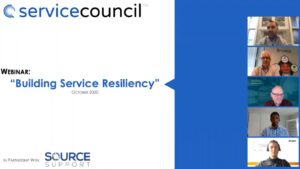Part 1: Defining a Resilient Services Framework
If there’s one thing that the COVID-19 pandemic has made clear to those of us in the service industry, it’s the importance of resiliency in our operations. Many organizations have been challenged this year in their staffing, logistics, workforce utilization and more, and as such it’s been difficult to provide consistent quality, responsive service. What’s more, end-users’ service expectations have grown significantly in the last couple of years, so organizations have had to adapt to challenges while trying to scale to meet their customers’ needs.
We’d like to break this all down for you in more detail and highlight some best practices in ensuring resilient service. In this post, the first in a three-part series, we want to define what a resilient services network should look like and talk about how to overcome some of the barriers and challenges to establishing a truly resilient service offering.
What does it mean for a service organization to be resilient?
- A strong culture. Before even thinking about customer service, you need to start with your own organization. You need to clearly articulate your vision, mission and values, and ensure people are bought into that culture. You also need to make sure people are happy in their jobs and they have a path to grow in the organization. When all of that is in place, then you add in the right technology, processes and communications to extend that culture throughout your service network and ensure people can work no matter what comes along. A strong culture and adaptable, consistent systems are the foundation on which you build everything else.
- A variable workforce. This means supplementing your full-time employee base with the right people, with the right training and certifications, in the right geographies to take care of your customers. By leveraging the variable model, you can create redundancies to ensure proper service anytime, anywhere.
- High utilization of field engineers. A recent Technology & Services Industry Association (TSIA) analysis of workforce productivity found that just 45% of the average FE’s total productive hours are spent on actual service work. There’s a lot of room for improvement in this area across our industry, and that will yield more efficiency, more tickets completed, improved outcomes and better management of your entire operation.
- A comprehensive, interactive foundation for managing service events and enabling visibility of the process every step of the way in real time. The more information you and your customers have, the better you can deploy your resources and the more efficient your service will be.
- Predictable, positive outcomes. You know what efforts produce optimal results, so standardize your workflows to achieve them as much as possible. This will maximize the bandwidth you and your FEs have to work through other situations that come along.
Using these points as a guide, we quickly realize that very little service delivery in the industry today is truly resilient. Worse yet, it seems we usually don’t know how our networks and systems are vulnerable until it’s too late.
So how do we build out a resilient service organization? Consider:
- Do you have the right people? Do they have the right skills? Do they have the right infrastructure and technology at their fingertips when they need it? It’s not easy to get the right mix of staff and/or third-party consultants in place, but it’s essential.
- Enabling consistent, real-time communication. This means having the right technology and systems for people to collaborate and share information across your organization no matter what’s happening inside or outside your offices. After all, there’s always something that comes along that can disrupt the flow of information or contribute noise.
- Providing consistent training. It’s really hard for a geographically diverse services team to be trained exactly the same way. But the better you do this, the better customer service you’ll deliver and the better you’ll hit your SLAs.
- Having a Plan B…and a Plan C. It’s not just about thinking through how you’ll handle certain situations in advance and ensuring you can deliver service when obstacles come along. It’s about hiring and training problem-solvers and practicing these responses, so that backup plans are actually implementable when they need to be. You don’t want to find yourself exposed when a situation (like a pandemic) comes along and you’re not ready for whatever reason.
In our next post, Jeff Nesler will delve into how he believes organizations can ensure positive outcomes from a resilient service model and what those organizations should be focusing on to ensure resiliency in the months to come.
Click here to read “A Resilient Services Framework, Part 2”.
Discover More from Source:
Want to continue exploring this subject? Watch our latest webinar “Building Service Resiliency”.

Source joins panel members from Hewlett Packard Enterprise (HPE), Stryker Canada, Vology, and The Service Council to discuss the three critical components to building a resilient service delivery capability.



It’s gratifying to see how making use of a robust global variable workforce has helped our customers deliver consistently high-quality service to their customers.